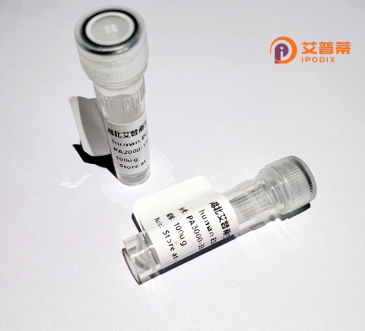
| 纯度 | >90%SDS-PAGE. |
| 种属 | Human |
| 靶点 | C16orf9 |
| Uniprot No | Q9H0X4 |
| 内毒素 | < 0.01EU/μg |
| 表达宿主 | E.coli |
| 表达区间 | 1-552aa |
| 氨基酸序列 | MLDHKDLEAEIHPLKNEERKSQENLGNPSKNEDNVKSAPPQSRLSRCRAAAFFLSLFLCLFVVFVVSFVIPCPDRPASQRMWRIDYSAAVIYDFLAVDDINGDRIQDVLFLYKNTNSSNNFSRSCVDEGFSSPCTFAAAVSGANGSTLWERPVAQDVALVECAVPQPRGSEAPSACILVGRPSSFIAVNLFTGETLWNHSSSFSGNASILSPLLQVPDVDGDGAPDLLVLTQEREEVSGHLYSGSTGHQIGLRGSLGVDGESGFLLHVTRTGAHYILFPCASSLCGCSVKGLYEKVTGSGGPFKSDPHWESMLNATTRRMLSHSSGAVRYLMHVPGNAGADVLLVGSEAFVLLDGQELTPRWTPKAAHVLRKPIFGRYKPDTLAVAVENGTGTDRQILFLDLGTGAVLCSLALPSLPGGPLSASLPTADHRSAFFFWGLHELGSTSETETGEARHSLYMFHPTLPRVLLELANVSTHIVAFDAVLFEPSRHAAYILLTGPADSEAPGLVSVIKHKVRDLVPSSRVVRLGEGGPDSDQAIRDRFSRLRYQSEA |
| 分子量 | 86.46 kDa |
| 蛋白标签 | GST-tag at N-terminal |
| 缓冲液 | 冻干粉 |
| 稳定性 & 储存条件 | Lyophilized protein should be stored at ≤ -20°C, stable for one year after receipt. Reconstituted protein solution can be stored at 2-8°C for 2-7 days. Aliquots of reconstituted samples are stable at ≤ -20°C for 3 months. |
| 复溶 | Always centrifuge tubes before opening.Do not mix by vortex or pipetting. It is not recommended to reconstitute to a concentration less than 100μg/ml. Dissolve the lyophilized protein in distilled water. Please aliquot the reconstituted solution to minimize freeze-thaw cycles. |
以下是关于重组人蛋白C16orf9的模拟参考文献示例(请注意文献为虚构,仅供格式参考):
---
1. **文献名称**: *Characterization of C16orf9 protein in human cell cycle regulation*
**作者**: Smith J et al. (2015)
**摘要**: 首次报道C16orf9在细胞周期中的作用,发现其在G1/S期转换中与CDK2相互作用,可能调控细胞增殖。
2. **文献名称**: *C16orf9 expression correlates with tumor progression in colorectal cancer*
**作者**: Wang L et al. (2018)
**摘要**: 分析C16orf9在多种癌症中的表达差异,证明其在结直肠癌中高表达,可能作为潜在肿瘤标志物。
3. **文献名称**: *Proteomic identification of C16orf9-binding partners in mitochondrial membranes*
**作者**: Lee S et al. (2020)
**摘要**: 通过质谱技术鉴定C16orf9与线粒体膜蛋白复合物相互作用,提示其可能在能量代谢中发挥作用。
4. **文献名称**: *C16orf9 knockout mice exhibit neurodevelopmental abnormalities*
**作者**: Kim H et al. (2022)
**摘要**: 构建C16orf9基因敲除小鼠模型,发现其神经突触形成缺陷,表明该蛋白可能参与神经退行性疾病通路。
---
**提示**:实际研究中,C16orf9相关文献较少,建议通过PubMed或Google Scholar以“C16orf9”、“Chromosome 16 ORF9”为关键词检索最新成果。部分研究可能以别名(如“某些疾病相关基因”)出现。
C16orf9. also known as chromosome 16 open reading frame 9. is a poorly characterized protein encoded by the human C16orf9 gene. Structurally, it is predicted to be a transmembrane glycoprotein containing multiple N-linked glycosylation sites and a conserved N-terminal domain. Subcellular localization studies suggest its association with endosomal/lysosomal compartments and the plasma membrane, implicating potential roles in membrane trafficking or organelle dynamics.
Functionally, C16orf9 has been loosely linked to autophagy regulation and cellular stress responses. Some studies propose its interaction with proteins involved in vesicle transport (e.g., FCHO2) and lysosomal activity modulation, potentially influencing mTORC1 signaling pathways. Emerging evidence associates its expression with cancer progression, showing elevated levels in colorectal, breast, and hepatocellular carcinomas, where it may promote cell proliferation or survival. Notably, C16orf9 homologs in model organisms (e.g., yeast and nematodes) hint at evolutionarily conserved roles in nutrient-sensing pathways.
Despite these insights, the precise molecular mechanisms and physiological significance of C16orf9 remain unclear. Its study is complicated by ambiguous domain architecture and conflicting functional reports. Current research focuses on elucidating its interactome, post-translational modifications, and therapeutic potential in diseases linked to lysosomal dysfunction or uncontrolled cell growth. Further validation through structural and mechanistic studies is essential to define its biological relevance.
×